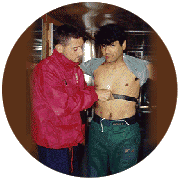Oxygen Consumption in the Mining Workplace at Altitude
(Development of a Hard Work Determination Tool)
Background
|
|
Most Chilean mines are located at altitudes of over 3,000 meters. The maximum productive capacity of a worker is reduced by about 10% per increase of 1,000 meters of altitude due to oxygen deficiency. There is a new "HARD WORK LAW" in Chile that requires a company to pay the equivalent of 1-2% of a worker's salary to the government and workers must pay 1% of their salary to the government for research into work intensity to determine a compensation scale based on four categories of measurement: physical, mental, environmental and organizational factors. |
These monies will also serve to assist with pensions and the determination of a legal retirement age. The law has not yet determined how to objectively evaluate and mix these four factors, except for the physical parameter of sea level oxygen consumption. Oxygen consumption above 40% of maximum at sea level constitutes "hard work" under the physical parameter. The current government process for determining "hard work" status is a subjective process conducted by a 7 person panel. Consequently, there is a need to measure and objectively determine what types of work at altitude are categorized as hard work and what types are not considered hard work.
Purposes of Research
The purposes of the research are to:
|
measure physical, mental, environmental and organizational factors in the mining workplace at altitude for all categories of workers, |
|
|
establish a scale of "work effort" at altitude, and |
|
|
set a concensus threshold for "hard work" or "not hard work" determination at altitude. |
Value to Comapanies and Workers
Companies will obtain an accepted measurement tool for distinguishing between "hard work" and "not hard work" jobs in high altitude workplaces. This will permit companies to reduce their payments to government for "hard work" positions. This will permit companies to compensate workers more equitably on the basis of "hard work" and "not hard work". Some workers will have reduced payments to the government where their positions are determined as "not hard work" positions. They may have potentially increased salaries for "hard work" positions. They might reduce their years of work and their age before retirement. Earlier retirement and younger worker replacements contribute to new ideas and lower base salaries for greater organizational efficiency and effectiveness.
There will be a more equitable model for compensation based on "hard work" or "not hard work"leading to improved management/labour relations.
Value to ACHS
ACHS will gain increased positive profile as a recognized leader in this field, with an early advantage to ACHS clients who will have first access to these tools. (Marketing)
Value to Chilean Society
More equitable compensation of workers. Reduced labour unrest over compensation issues. Earlier retirement with improved quality of life and improved employment opportunities for young workers.
METHODOLOGY
In five predetermined positions in a mining company at altitude (Minera Zaldivar), measure and evaluate the physical, mental, environmental and organizational factors of their work, establish a scale and reach a concensus. Parameters Over a period of 10 months (October 1999 - August 2000):
|
Physical. Measure the real oxygen consumption in the workplace at altitude, the maximum oxygen consumption at altitude (under laboratory conditions at the work site), and the maximum oxygen consumption at sea level. |
|
|
Mental. Measure abstract and mathematical thinking and spacial recognition using established psychological tests developed by the ACHS and the University of Antofagasta. (These 13 tests were proven as statistically valid with 110 subjects.). |
|
|
Environmental. Measure carbon dioxide, carbon monoxide, sulphur dioxide, airborne dust, metals in dust (arsenic, lead). Measure ambient, skin and body core temperature as a result the types of clothing and protective devices worn. |
|
|
Organizational. Collect data on the distance traveled to and from work, hours worked per day, kinds of shifts (includes meal and rest periods and conditions) , supervisory responsibilities. All of the data will then be matrix analyzed and scaled to create an objective concensus measurement tool. |
(Approved) Outcome
At the end of a 10 months ACHS and its member companies will have a measurement tool to use for the several purposes associated with the Chilean "Hard Work Law".
Funding
By ACHS (70%, mainly salaries, samples, devices, Minera Zaldivar (30%, mainly time off work for evaluation, administrative support, environmental measurements), TOTAL COST $9,550,000 Chilean Pesos.
